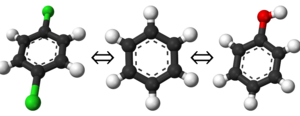Simulation Acceleration
| Free Energy Fundamentals |
|---|
 |
|
Methods of Free Energy Simulations
|
| Free Energy How-to's |
|---|
 |
In many cases of interest, carrying out robust free energy calculations may require significant investment of computational resources, beyond that which can be obtained by most researchers. This page examines additional tools for accelerating the sampling. As these begin to branch out from the fundamentals of free energy, we will not go deeply into all these methods. They are not needed to carry out free energy calculations, but they may be extremely useful to converge calculations in complex systems with slow dynamics and we encourage readers to examine these topics to see what will work for them.
Umbrella Sampling
One standard method for improving sampling in atomistic simulations is umbrella sampling,[1] where bias terms are added to constrain the simulation in some way, then the restraints are removed. This methods can lower barriers on the potential energy surface, or restrain simulations to slow-interconverting configurations that are relevant to the binding affinities (e.g. different torsional states). Doing this allows for the free energy components to be properly computed and then combined. [2] [3] [3] If a system has slow degrees of freedom, like some hydration free energies, [4] this method allows one to sample more frequently in the slow state.
One can also envision using umbrella sampling to compute the free energy of constraining the free ligand into the bound conformation directly before computing the free energy of binding, and then computing the free energy of releasing these restraints in solution. Doing so usually decreases correlation times for sampling intermediate states, thereby increasing the simulation efficiency. [2] [5]
Hamiltonian Replica Exchange
Other Methods
References
- ↑ Torrie, G. M., and Valleau, J. P. (1977) Non-physical Sampling Distributions in Monte-Carlo Free-Energy Estimation : Umbrella Sampling. J. Comput. Phys. 23, 187–199. - Find at Cite-U-Like
- ↑ 2.0 2.1 Wang, J., Deng, Y., and Roux, B. (2006) Absolute Binding Free Energy Calculations Using Molecular Dynamics Simulations with Restraining Potentials. Biophys. J. 91, 2798–2814. - Find at Cite-U-Like
- ↑ 3.0 3.1 Mobley, D. L., Chodera, J. D., and Dill, K. A. (2007) Confine-and-release method: Obtaining correct binding free energies in the presence of protein conformational change. J. Chem. Theory Comput. 3, 1231–1235. - Find at Cite-U-Like Cite error: Invalid
<ref>tag; name "Mobley2007" defined multiple times with different content - ↑ Klimovich, P. V., and Mobley, D. L. (2010) Predicting hydration free energies using all-atom molecular dynamics simulations and multiple starting conformations. J. Comp. Aided Mol. Design 24, 307–316. - Find at Cite-U-Like
- ↑ Woo, H.-J., and Roux, B. (2005) Calculation of absolute protein-ligand binding free energy from computer simulation. Proc. Natl. Acad. Sci. 102, 6825–6830. - Find at Cite-U-Like